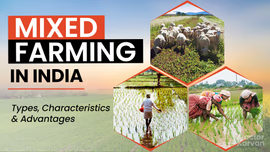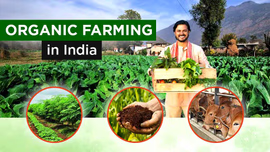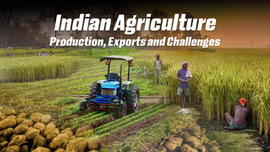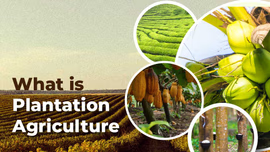India's Rubber Industry: Cultivation, Production, and Economic Impact

Table of Contents
- Introduction
- Types of Rubber
- Rubber Plantation in India
- Steps in Rubber Cultivation
- Top Rubber-Producing States in India
- Government Initiatives to Promote Rubber Plantation
- Conclusion
Introduction
Rubber plantation plays a significant role in the economy of the country. The production of rubber is one of the oldest as it was first planted in India during the early British colonialism in the late 19th century. It was mainly cultivated to supply natural rubber to the rising market to source the products from countries such as Malaysia and Sri Lanka.
Rubber business in India is improving immensely as exports have a large impact on India’s income. It also renders employment to so many people across the nation. The rubber products made from rubber trees can therefore be categorized as export oriented and are used in automobile manufacture, shoe production, construction, and medical use among others. Rubber plantations are among the important sources of cash crops in the agricultural fields of India and it also uplifts the socioeconomic standard of those areas where it is grown.
Types of Rubber
Rubber is classified into different types based on whether it is natural or synthetic. Here are some of the varieties of natural rubber that are widely used:
Hevea Brasiliensis - also known as Para rubber tree, is the primary source of producing natural rubber globally.
Ficus Elastica - is a type of rubber that is majorly extracted from the Indian rubber tree and is widely used in various commercial applications.
Variety of Rubber clones
|
Sr. No. |
Name |
Characters |
|
1 |
TJIR - 1 |
Indonesian clone |
|
2 |
G.T.1 |
Indonesian clone |
|
3 |
G.I.1 |
Malaysian clone |
|
4 |
P.B. 86 |
Malaysian clone |
|
5 |
PRIM-600 |
Developed by Rubber Research Institute of Malaya (RRIM). |
|
6 |
RRIM. 628 |
Developed by RRIM |
|
7 |
RRIM - 703 |
Developed by RRIM |
Rubber Plantation in India
Rubber plantation in India started in 1895 at the hilly regions of Kerala particularly in the Kottayam and Kollam districts. The major factor that supports Kerala to as a suitable region for rubber plantation is the climatic factors of tropical region coupled with right amount of rainfall. However, it has to be noted that commercial cultivation of rubber was initiated in 1902.
India is the third largest producer of rubber in the world whereas Kerala is the largest rubber producing state of India. Natural rubber is selectively collected as latex from the rubber tree. Rubber trees are versatile as rubber materials are used in day-to-day life and some parts of the tree including the leaves portions are used as natural anti-inflammatory agent.
Steps in Rubber Cultivation
Rubber cultivation in India involves several steps to ensure a successful yield. Here are the key steps involved in rubber plantation:
Soil & Climate
Rubber plants need a warm and humid climate with adequate rainfall throughout the year. The average temperature required for its growth is 20 to 35°C and the annual rainfall required for its cultivation is 1500-3000 mm. Rubber plants bloom in well-drained, loamy soils that are rich in organic matter and have good moisture retention capacity with a proper source of drainage.
Land Preparation
The major pre planting preparation before starting rubber cultivation is to clear all vegetation. Rubber plantation can be done on hilly, forest areas, and flat lands too. The process of land preparation remains the same except between hilly and flat land type.
Plantation
The best season for rubber plantation is July-September. In the course of plantation, sufficient space is provided while planting seeds in the pit. It is recommended that there should be a space of 6 to 7 meters between each plant with regards the type of rubber plant that is being grown. This enables each tree to find a place to grow without crowding in an effort to get adequate amount of sun light.
Ideal Spacing:
Triangular Shape- 4. 9m x 4. 9m
Hilly areas - 6. 7 x 3. 4 m
On areas which are flat (square) – 4. 9m x 4. 9m
After Care
Mulching and covering the plant with dry leaves is a best practice in rubber plantations to protect the crop and avoid soil degradation.
Benefits:
- Improves the water holding capacity of the soil
- Improves the soil
- Helps in maintaining a cool and moist condition around the crop during summer
- Protecting the soil from heavy rainfall to avoid soil erosion.
Tapping
During the tapping process, latex is obtained from the bark of the rubber tree. Tapping is performed to control wounds while removing the thin shaving from the barks. During the tapping process, latex is obtained from the bark of the rubber tree. Tapping is performed to control wounds while removing the thin shaving from the barks.
Processing
The latex that comes out from the rubber trees while performing the tapping process is collected in a container, generally channeled in coconut shell cups, which are attached to them. Latex collected is later transferred to clean buckets after two or three hours of tapping.
Top Rubber-Producing States in India
India is one of the leading producers of natural rubber in the world. At present, approximately 8.5 lakh hectares of land are devoted to rubber cultivation in India. Out of this, Kerala and the Kanyakumari district of Tamil Nadu account for almost 5 lakh hectares, while Tripura has 1 lakh hectares under rubber cultivation. Since Kerala is the leading rubber-producing state in India, it is also known as the "Rubber Capital of India,". Tamil Nadu, Tripura, Karnataka, and Assam also contribute significantly to rubber production in India due to their favorable tropical climate.
Here is the list of some top rubber-producing states in India with total production in tons.
|
Sr. No. |
State |
Rubber Type |
Production (Tons) |
|
1 |
Kerala |
Widely grows RRII 105 |
4,90,960 |
|
2 |
Tripura |
Hevea brasiliensis (Natural Rubber) |
53,050 |
|
3 |
Karnataka |
Hevea brasiliensis (Natural Rubber) |
38,200 |
|
4 |
Assam |
Genetically Modified (GM) |
24,300 |
|
5 |
Tamil Nadu |
Hevea brasiliensis (Natural Rubber) |
21,5004 |
|
6 |
Meghalaya |
Hevea brasiliensis (Natural Rubber) |
9,100 |
|
7 |
Nagaland |
Hevea brasiliensis (Natural Rubber) |
4,930 |
|
8 |
Manipur |
Hevea brasiliensis (Natural Rubber) |
1,850 |
|
9 |
Mizoram |
Hevea brasiliensis (Natural Rubber) |
750 |
|
10 |
Goa |
Hevea brasiliensis (Natural Rubber) |
625 |
Government Initiatives to Promote Rubber Plantation
The Indian government has implemented various initiatives to promote rubber plantations in the country to support the rubber industry. Some of these key initiatives include:
Sustainable & Inclusive Development of Natural Rubber Sector scheme
To support rubber industry and to increase the shortfall of rubber production, the Union Government of India has increased the financial assistance under ‘Sustainable & Inclusive Development of Natural Rubber Sector scheme’ for the next two years (2024-25 and 2025-26). Earlier it was INR 576.41 crore, now the increased allocation is INR 708.69 crore.
The government came up with an initiative to set up three major Rubber Training Institutes in the Northeast part of India promoting the development of rubber producing industries in this region.
Objectives of the scheme:
1. Promoting and increasing rubber plantation
2. Development of Infrastructure
3. Training rubber growers with the best practices
4. To improve income and employment rate.
Collaborative Projects in the Northeastern States
The Rubber Board, in partnership with the Central government and the Automotive Tyre Manufacturers' Association, has initiated a project to increase the area dedicated to natural rubber cultivation in the Northeastern States.
These initiatives exhibit the government's efforts to overcome the challenges faced by the rubber industry and promote sustainable rubber cultivation across different regions of India.
Conclusion
The rubber industry in India has shown remarkable growth to date and has been indispensable for its economic contributions, foreign exchange earnings, and industrial use. However, there are many challenges involved in the cultivation of rubber plants such as ideal climatic and soil conditions, prevention from pests, price volatility, and environmental concerns. To ensure sustainable growth of rubber plants, it is required to focus on research, sustainable practices, market diversification, and government support. By fulfilling these requirements, India can produce more rubber and strengthen its position globally in the export of rubber goods.
Frequently Asked Questions On India's Rubber Industry: Cultivation, Production, and Economic Impact
1. How many rubber trees can be planted in 1 acre?
Approximately 500 trees can be planted on 1 acre of land.
2. Is rubber farming profitable in India?
Yes, rubber farming is a profitable business as farmers have a scope of making upto one lakh rupees in a year from an acre of rubber plantation.
3. How to start a rubber tree plantation?
To start a rubber tree plantation, start by finding a mother plant, then cut a section to propagate, stick it in water, and wait for roots to form. Finally, place the propagated rubber plant stem in the soil.
4. What is the fertilizer for rubber plantations?
Mature rubber under-tapping is the name of rubber plant fertilizer that is used in rubber plantations.
5. Which state is famous for rubber cultivation?
Kerala is the most popular state for rubber cultivation in India.
6. How much rainfall is required for rubber plantation?
Rubber trees require moist and humid climates with heavy rainfall of more than 200cm.
7. Which soil is best for rubber?
Loamy soil having well drainage facilities is considered best for rubber plantation.


Related Blogs












